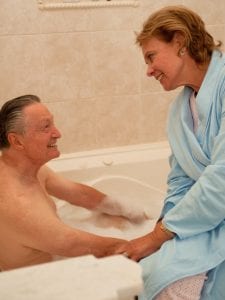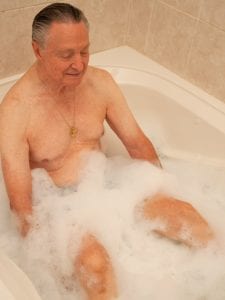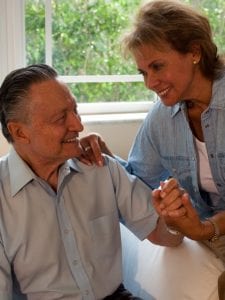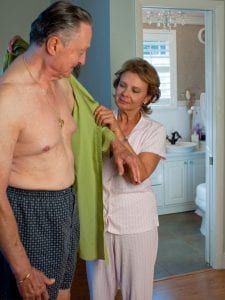Welcome to the educational program Assisting with Daily Activities of Daily Living: Bathing and Showering. This program will present the principles for assisting people with Alzheimer’s disease to perform activities of daily living, also called ADLs or self-care activities, with a focus on the activities of bathing and showering. It will help you understand the factors that can make bathing and showering challenging activities for individuals with Alzheimer’s disease and their caregivers, and provide strategies for assisting with bathing and showering. This includes tips on how to design a bathing space for safety and comfort.
. . .
This is Lesson 3 of The Alzheimer’s Caregiver. You may view the topics in order as presented, or click on any topic listed in the main menu to be taken to that section. We hope that you enjoy this program and find it useful in helping both yourself and those you care for. There are no easy answers when it comes to the care of another, as every situation and person is different. In addition, every caregiver comes with different experiences, skills, and attitudes about caregiving. Our hope is to offer you useful information and guidelines for caring for someone with dementia, but these guidelines will need to be adjusted to suit your own individual needs. Remember that your life experiences, your compassion, and your inventiveness will go a long way toward enabling you to provide quality care.
Let’s get started.
Prefer to listen to this lesson? Click the Play button below.
Activities of Daily Living (ADLs or Self-Care Activities)

One way of looking at assisting with activities of daily living is to think of them as opportunities to spend more quality time with the person. Performing ADLs is basic to one’s sense of dignity, autonomy, and mastery. Loss of these abilities can lead to frustration, embarrassment and a sense of inadequacy. In addition, fear and frustration associated with ADLs are the source of most difficult behaviors. For these reasons, it is extremely important that caregivers approach ADLs with understanding and compassion, as this will go a long way toward preventing difficult behaviors and improving the quality of life for the caregiver and care recipient.
If handled well caregivers can help those with dementia express their independence and build their self-esteem through ADLs.
In addition, fear and frustration associated with ADLs are the source of most difficult behaviors. For these reasons, it is extremely important that caregivers approach ADLs with understanding and compassion, as this will go a long way toward preventing difficult behaviors and improving the quality of life for the caregiver and care recipient.
If handled well, caregivers can help those with dementia express their independence and build their self-esteem through ADLs.
Aging Factors
Alzheimer’s disease typically affects people in their older years, so the changes associated with aging, as well as dementia must be taken into consideration. Aging factors that affect bathing include the person’s skin, which becomes thinner and more fragile, making it easier to bruise or injure. The body’s temperature regulating system declines with aging, so older people are more sensitive to temperature, particularly to cold. They may feel chilled even when others feel warm. Due to declining vision and hearing, older people may not be able to hear instructions well or see things clearly, such as the hot and cold labels on water taps. With aging, joints can become stiff and painful, which can limit motion and cause unsteadiness. This is especially important because falls become a greater risk due to reduced mobility and balancing ability.
Dementia Factors
In addition to aging, changes associated with dementia also contribute to loss of functionality. Dementia causes memory loss, or amnesia. This loss of memory initially involves predominantly short-term memory, such as where they put their slippers or when they last had a bath. Over time, the memory loss includes more and more distant memories. Automatic skills, such as bathing and brushing teeth, are also gradually forgotten due to damaged brain cells. The loss of automatic skills or inability to use common objects is called apraxia.
Recognition, or the ability to recognize images, also declines as Alzheimer’s progresses. For example, the person may not recognize a bottle of shampoo or washcloth. This inability to recognize objects is called agnosia.
Alzheimer’s disease also affects the language centers of the brain. So the person will have increasing difficulty understanding and creating speech. This is called dysphagia or aphasia.
Attention and concentration decline as well. As Alzheimer’s progresses, the ability to pay attention and concentrate on a task gradually decreases.
Stress threshold recognition declines, meaning that people with Alzheimer’s often do not know when or how much they are stressed. They also have a lower threshold for stress, so they feel stress more easily. Their ability to avoid stress also decreases, and they cannot anticipate when stress may increase.
Impulse control declines.The ability to control one’s impulses is called the executive function. Alzheimer’s causes damage to the front part of the brain, which controls executive function. Poor impulse control can lead to yelling, fighting, hitting, pinching, or throwing things.
Additionally, organizational ability declines. Damage to the front part of the brain also results in loss of organizational ability. Self-care activities require organizational ability: that is, knowing what to do, when to do it, and how to prepare the necessary items.
Lastly, people with dementia can have difficulty adjusting to new surroundings, which may cause confusion, fear, and a negative reaction to performing activities of daily living. When planning and assisting with ADLs, you should consider whether the person is in an unfamiliar environment, such as a long-term care facility.

Automatic skills such as bathing and brushing teeth, are also gradually forgotten due to damaged brain cells. The loss of automatic skills or inability to use common objects is called a apraxia. Recognition or the ability to recognize images, also declines as Alzheimer’s progresses. For example, the person may not recognize a bottle of shampoo or washcloth. This inability to recognize objects is called agnosia. Alzheimer’s disease also affects the language centers of the brain, so the person will have increasing difficulty understanding and creating speech. This is called dysphagia or aphasia.
Attention and concentration decline as well. As Alzheimer’s progresses, the ability to pay attention and concentrate on a task gradually decreases. Stress threshold recognition declines, meaning that people with Alzheimer’s often do not know when or how much they’re stressed. They also have a lower threshold for stress so they feel stress more easily. Their ability to avoid stress also decreases and they cannot anticipate when stress may increase.
Impulse control declines. The ability to control one’s impulses is called the executive function. Alzheimer’s causes damage to the front part of the brain, which controls executive function. Poor impulse control can lead to yelling, fighting, hitting, pinching, or throwing things. Additionally, organizational ability declines. Damage to the front part of the brain also results in loss of organizational ability. Self-care activities require organizational ability, that is knowing what to do, when to do it, and how to prepare the necessary items.
Lastly, people with dementia can have difficulty adjusting to new surroundings, which may cause confusion, fear, and a negative reaction to performing activities of daily living. When planning and assisting with ADLs, you should consider whether the person is in an unfamiliar environment such as a long-term care facility.
Case Study 1
Let’s begin with an example about Mary and her husband, Robert, who has Alzheimer’s disease. Mary is expecting her friend Gladys for a visit and is rushing to get everything done before her arrival.- A) She could try reducing frequency of showering to 1 to 3 times a week with towel baths or spot cleansing on other days.
- B) Mary could have covered Robert with a blanket, robe, or towel while he was undressed and waiting to enter the shower.
- C) Mary should not have left Robert alone, particularly in a cold and drafty bathing area, or in areas where wet floors could cause a fall.
- D) Mary should have placed Robert’s needs before her own agenda. Robert indicated that he wanted to take a nap.
- E) All of the above.
Answers:
Choice A: “She could try reducing the frequency of showering to 1 to 3 times a week with towel baths or spot cleansing on other days” is a good choice.
Older people produce less perspiration and oils from their skin than younger people, so they do not produce as much odor. Bathing too frequently, particularly with harsh soaps, can be harmful to thinner, more fragile skin. So avoid harsh soaps and too much scrubbing. On the other hand, skin needs to be cleansed to remain healthy. Regular cleansing of the body is important, because limited mobility and excess dirt and oil on the body can increase the risk of bedsores or pressure ulcers. This can also lead to infections. For individuals who take full baths or showers only 1 to 3 times a week, their bottoms and genitals should be washed or cleansed more frequently to prevent infections and reduce odors.
Choice B: “Mary could have covered Robert with a blanket, robe, or towel while he was undressed and waiting to enter the shower” is another good choice.
Covering exposed body parts prevents chill and also respects privacy. Provide draping towels, robes, or blankets for modesty if the person is undressed and minimize the time that they spend undressed. Do not have the person undress until everything is ready for the bath or shower.
Choice C: “Mary should not have left Robert alone, particularly in a cold and drafty bathing area or in areas where wet floors could cause a fall” is another possibility.
Caregivers should not leave someone with dementia alone in potentially dangerous areas or situations. Mary could carry a cordless or mobile phone with her or let the phone ring, rather than leaving Robert to answer the phone.
Choices D and E: “Mary should have placed Robert’s needs before her own agenda” is also a good choice.
Robert indicated that he wanted to take a nap. Mary should have found out if he was tired or in pain or needed anything. Robert has arthritis and feels pain with certain movements. He also has difficulty sitting on hard surfaces for long periods of time. The movements involved with bathing often trigger his arthritic pain, which makes bathing an uncomfortable activity. Pain can cause a person to be fatigued, depressed and irritable. Chronic conditions such as arthritis require frequent assessment for pain and continual pain management. On days of physical activities such as bathing or showering, pain medication should be given prior to the activity as a preventive measure. And activities should be planned for times when the person is not tired.
Choice E: Because all of the previous choices are good possibilities, Choice E, “all of the above,” is the best choice.
The Bathing Environment
When planning a bathing activity, caregivers should first modify the bathing environment to insure a safer and more positive experience. The bathing environment can be divided into two categories, the physical and the human. The physical environment includes the actual space, furniture, lighting and temperature. The human environment supports autonomy, comfort, love, and respect.

Bathrooms in the home are often ill designed for persons with dementia or physical disabilities. Due to this, the bathroom may need to be adjusted or reorganized to accommodate someone with dementia. In adjusting the room, caregivers need to consider the space, floors, doors, and how convenient it is to the person with dementia.
It is helpful to have a bathing area that has ample space for two people to work easily so that the caregiver can access the care recipient from at least 2 sides. As mobility declines in the later stages of the disease, it is also helpful to have enough space to place a comfortable chair or even wheelchair in the bathing area. If a shower is preferred, it is helpful to have a shower stall large enough to accommodate two persons and a chair or wheelchair if necessary.
Physical Bathing Environment

Falls are the leading cause of injury resulting in death among people 65 years and older, according to the National Center for Injury Prevention and Control. They are also the most common cause of nonfatal injuries and hospital admissions for trauma. There are many steps one can take to reduce the risk of falls.
Make sure floors have a non-slip surface and are dry. Place nonskid floor mats/bathmats on tile floors. Bathtubs and shower stall floors should have safety strips or nonskid bathmats that stick to the surface. Avoid putting things into the bath water, such as bath oils, that will make the bathtub slippery. Consider installing rubberized or unglazed ceramic tile floors in shower stalls.
Lastly, carpeted floors of a single color are safer and more comfortable for bare feet than non-carpeted floors and will not produce glare.
Organization is also very important in providing a safe environment. Too many objects in a room can cause confusion, be distracting, and increase the risk of accidents. Extra cupboards, magazine racks, and laundry hampers, for example, can cause confusion. Simplify the environment by reducing unnecessary objects such as televisions, fans, free-standing heaters, power cords, and extra furniture. Clutter on counters and obstacles on the floor should be removed. Label and lock away cleaning solutions and other harmful substances, because they can be mistaken for shower gel, shampoo, or toothpaste. Make sure the door locks can be opened from the outside. Or consider removing or disabling the locks, because people with dementia may lock themselves in a room and forget how to open the door.
Physical Bathing Environment: Furniture and Lighting

Proper shower or bathtub chairs and benches are important safety features. Chairs and benches with padded seats and backs increase comfort while sitting. Some chairs and benches have a large hole in the center, but this is uncomfortable and unnecessary. Chairs with several, small, smooth drainage holes work best. For non-fixed chairs, non-slip grippers on the chair’s feet will increase their safety. Sling seats and fold-down chairs are other options for the bathtub or shower.
A handheld showerhead should also be installed in place of overhead shower fixtures to allow control over the direction of the water. A shower within a bathtub can be awkward and even dangerous for someone with limited mobility. A bathtub can also be difficult for older persons to get in and out of. To make the bathtub safer, use a handheld shower head and a bathtub chair, fold down seat, or sling seat.
Sturdy hand rails and grab bars are essential, whether near the bathtub, shower stall, or toilet. Towel racks should never be used for steadying or leverage in lifting, as they are not sturdy enough.
Because many people reach for doors or door handles and furniture to steady themselves, it is important to have sturdy, stable furniture and door handles to prevent falls.
Proper lighting is important for preventing injuries. Provide bright overhead and task lighting. Older people need more lighting than younger people in order to see properly. Reduce glare by using indirect lights and covering windows with light, sheer curtains.
Lastly, contrasting colors are important for spatial orientation. Try to paint walls a flat color that contrasts with the color of the floors.
Physical Bathing Environment: Entering and Exiting Bathtubs

Assisting someone to get in and out of a bathtub can be very challenging if the person has limited mobility. To help with stability and leverage, one or more grab bars should be installed near the bathtub. If the bathtub is low, the person may be able to step over while holding onto a grab bar with one hand and being assisted by the caregiver with the other arm and hand. If the bathtub is higher, the person may be able to sit on the edge while a caregiver assists her or him to swing the legs over the edge one at a time.
A transfer bench can be used to ease transfers in and out of the tub. To get in, the person sits on the part of the bench outside the tub and slides over and into the tub, using grab bars and caregiver assistance.
Getting out of the bathtub is harder than getting in, because the person is wet and sitting down with legs out in front. The person will need to hold a grab bar or overhead trapeze and have assistance to rise up.
If there is concern for falls while getting out of the tub, let the water drain out first and avoid using bath oils that will make the tub slippery.
A sling seat that fits over the sides of the bathtub allows the person to sit nearly level with the tub’s edge. This can make it easier to get in and out of the bathtub, but limits the opportunity for a good soak in the water.
There are commercial models of tubs created for nursing homes that have side doors so that people can step in and out of them rather than over the side as with household bathtubs. Their size and shapes can be daunting. However, these might work very well for some caregivers and their living situations.
Finally, when the person is ready to get out of the bathtub or shower, there should be a nonslip covering on the floor, such as a bathmat, and a ready towel and robe for modesty and comfort.
Physical Bathing Environment: Water Temperature

Water temperatures greater than 120 oF can scald a person and may require medical treatment. It doesn’t take more than a second or two for someone to get a serious burn if the water is really hot. Additionally, the elderly and those with dementia and/or reduced mobility have delayed reactions to a sudden rise in water temperature. The dilemma is that, to maintain a hot water supply safe from bacteria, the CDC recommends a hot water temperature of 140 oF. The best way to determine water temperature is to measure with a water thermometer. A safe and comfortable bathwater temperature is usually around 100 oF. It is a good idea to feel the water for yourself, so that you get a sense of what that safe water temperature feels like. Generally, if the water feels too warm for the caregiver, it could be dangerously warm for the elderly person. Keep in mind that the water needs to be warm enough that the person does not become chilled.
If you are going to use water heated above 114 oF, consider installing some form of anti-scald device in your home. Anti-scald devices reduce water flow to a trickle when the output water temperature exceeds a set limit, such as 120 oF.
A common type of anti-scald device is a pressure-balancing valve. The devices sense when there is too little cold-water or too much hot-water pressure, and can maintain a mix of hot and cold water to within 3 oF of a desired temperature (for example: 100 to103 oF). A more expensive, option is an anti-scald device that adjusts for both temperature and pressure differences.
Here are some additional tips for preventing burns. If the faucet has separate taps for hot and cold water, consider switching to safer, single lever faucets. Single levers are easier to balance the water temperature and less confusing to someone with dementia and/or visual impairment, who may not remember which tap is hot or cold.
If the hot and cold water labels are not clear, consider placing clear hot and cold labels that easily identify which tap or direction is which.
When turning on the water, start running the cold water from the faucet first, and then add the hot water.
Lastly, consider placing soft or childproof covers on faucet taps to prevent the person from turning on or adjusting the water without supervision.
Human Environment

The human environment should aim to promote autonomy, comfort, love and respect. An important principle in any care-related activity is referred to as person-centered care as opposed to task-focused care. The main principles of person-centered care are that it focuses on the person. It takes into consideration the person’s comfort, feelings, preferences, abilities, history, strengths, and addresses any needs. Agitation during bathing can occur when the caregiver is focused on the task rather than the comfort and needs of the care recipient. Challenging behaviors such as agitation and combativeness need to be seen as expressions of unmet needs rather than oppositional behavior. It is important for caregivers to know the things that make their care recipients unique and to respect them and their personal preferences.
If individuals become anxious and reluctant to bathe, ask them (or try to determine from their body language) what might be frightening them or what they might need before the bath. They may need to use the toilet or may be having pain. Or perhaps they would like a snack or a drink before bathing.
By gathering information and applying your knowledge about individuals, you empower yourself with the ability to create positive strategies that can enhance their quality of life.
Human Environment: Good Communication Skills

Another effective tool for successful bathing is the use of good communication skills, which includes gaining eye contact, speaking clearly and slowly, using familiar terms, repeating and reminding as needed, using effective expressions and gestures, and observing the person’s body language for comprehension and comfort. When speaking to the person, say the important words last, as people are more likely to remember the last word. Break up activities into simple steps and give only one or two instructions at a time. For example, say here is the soap, please wash your hands. Then say, here is a washcloth, use the washcloth to wash your arms, as you hand each item to the person. Adapt your instructions based on the functional and cognitive levels of the person, remembering that these levels may fluctuate, so try and keep reasonable expectations for performance. Plan the activity to allow the person to succeed by simplifying the steps to fit her or his remaining abilities.
Human Environment: Simple Routines
Caregivers should follow simple, familiar routines for bathing. Bath items should be simple and assembled before the bath so that the person has fewer objects to figure out. Items should be organized and within easy reach when needed so time is not wasted looking for things.

Break up the bath or shower activity into smaller, more manageable steps if a full bath or shower is distressing or overwhelming to the person. For example: If the person is in a more advanced or physically frail condition, it might be best to shampoo the hair at a different time from the bath. It may be too fatiguing to do both. Another way to break up the bath is to wash the upper body on one day and the lower body on another day.
Which method to use (bath, shower, towel or sponge bath) should be based on the lifestyle and preferences of the care recipient. Offering the person the choice of shampooing before, after, or during the bath can provide a sense of some control in the experience.
Evaluate the best time of day for bathing or showering. Consider what part of the day the person is most relaxed. Take into consideration the person’s lifestyle and preference. The best time of day for bathing or showering may change from time to time.
Human Environment: Promoting Comfort
The bathing experience needs to be tailored to the needs and comfort level of the person being bathed to reduce discomfort and increase enjoyment. Try to have the bathroom completely prepared prior to bringing the person in for the bath or shower. Having all the supplies ready and within arm’s reach will limit delays during the activity.

If the sound of running water causes agitation, fill the tub before the person enters the room.Otherwise, the water should be nearly drawn when the person arrives in the tub room, so as not to take time filling the tub, but to give the person a chance to test the water and adjust the temperature if necessary. It is safer to have the water cooler when she or he steps in and then warm it up if desired.
Make sure individuals are comfortable on the way to the bathing area whether they are walking, in a wheelchair, or in a shower chair. If they are already undressed, keep them well-covered and warm.Adjust the room temperature to a comfortable setting for older people, as they tend to chill easily.If the person is undressed and waiting to enter the bath or shower, cover the body with a blanket, towel, or robe.
Have a large towel handy to cover the person while other parts are being washed. Yes, the towel will get wet, but the person will be covered, and even a cotton towel can provide some warmth in a shower or bathtub.
Try warming the bath towels, blanket, or robe in the dryer for a few minutes just prior to use, as this can increase comfort and the likelihood of participation.
Human Environment: Pleasant Environments
A familiar caregiver with a pleasant, calm manner should assist with bathing. Caregivers should not leave the person unattended in the bath, shower, or other potentially hazardous area, or allow themselves to be distracted for extended periods of time.
Having some familiar and pleasant objects in the room can help to relax and comfort the person. For example, place flowers in a vase that the person likes on the bathroom counter, put out preferred soaps and lotions, and display appealing objects such as wall art, plants, and colorful towels.
Don’t forget to consider the sounds, smells and lighting in the environment. Try playing calming or preferred music, or leave the room  quiet. Use relaxing fragrances, such as lavender or Melissa oil (lemon balm). Studies have shown that using relaxing fragrances with massage, such as of the arms and face, can help reduce agitation and anxiety.
quiet. Use relaxing fragrances, such as lavender or Melissa oil (lemon balm). Studies have shown that using relaxing fragrances with massage, such as of the arms and face, can help reduce agitation and anxiety.
It is important to provide good lighting, without glare or shadows that can confuse or frighten the person. If someone is confused by reflections or becomes frustrated by the inability to recognize one’s face, cover or remove mirrors.
Human Environment: Monitoring Fatigue and Pain

Fatigue and pain must be monitored, as they are frequent reasons for those with dementia to refuse bathing and dressing. Physical disabilities (such as weakness, fatigue, pain and joint stiffness) and sensory impairments (such as visual or hearing loss) must be considered in planning and assisting with ADLs. Pain can cause a person to feel fatigued, depressed, and/or irritable. It can be difficult for someone with dementia to let others know that they are in pain or feel tired. Caregivers should make frequent assessments for pain and provide proper pain management. Both listen and look for body language and other signs of fatigue and discomfort. If there are signs of fatigue, take a break or switch to an easier activity and address any source of discomfort. Make sure the person is as pain-free as safely possible. On days of physical activities such as bathing or showering, consider giving pain medication prior to the activity as a preventive measure. Take into consideration that some pain medications can cause drowsiness or dizziness, which may increase the risk of falls or accidents, especially while bathing or showering. Consult a healthcare professional about pain management and any concerns that you may have.
Human Environment: Promoting Autonomy and Independence
Promoting autonomy and independence can help those with dementia to maximize individual abilities and minimize disabilities. Caregivers  should encourage individuals to use their remaining abilities by doing as much for themselves as possible while maintaining safety and security. Reinforce effort and show appreciation by giving praise for both successful and unsuccessful efforts. Because bathing is such a personal activity, caregivers need to allow individuals to do as much as they are comfortable and capable of doing for themselves. For example, caregivers should always offer to let others wash their own face, a painful joint, or their genital area. If it is necessary for caregivers to do the washing, they should always ask permission. One can say something like, “It’s time to wash your private parts, your face, or your sore arm. Is that alright?” Give the person choices appropriate to the level of the person’s abilities, but not so many that they become frustrated. Examples of choices include morning or evening bath, shower or tub, and shampoo hair with the bath or separately.
should encourage individuals to use their remaining abilities by doing as much for themselves as possible while maintaining safety and security. Reinforce effort and show appreciation by giving praise for both successful and unsuccessful efforts. Because bathing is such a personal activity, caregivers need to allow individuals to do as much as they are comfortable and capable of doing for themselves. For example, caregivers should always offer to let others wash their own face, a painful joint, or their genital area. If it is necessary for caregivers to do the washing, they should always ask permission. One can say something like, “It’s time to wash your private parts, your face, or your sore arm. Is that alright?” Give the person choices appropriate to the level of the person’s abilities, but not so many that they become frustrated. Examples of choices include morning or evening bath, shower or tub, and shampoo hair with the bath or separately.
Provide cues and guidance only when needed and without taking over. Remind them of the next step if they seem to have forgotten and offer practical help. For example, offer the soap and hold out a washcloth when it is time to use them, or place a soapy washcloth in the person’s hand, as this may help cue the person to wash. You may need to demonstrate the step if necessary, as watching someone perform a task can sometimes prompt a person with dementia to imitate it. For example, use a washcloth to wash part of your arm if the person seems confused about what to do with a washcloth. Although it may be difficult to watch others struggle through an activity, it is better to let them try it and offer help only they need it, so use hand-over-hand guidance only when necessary and with permission.
Finally, allow plenty of time for bathing or showering, as it is an important part of the day. Bathing activities usually take longer than you might expect, so plan enough time and do not rush, as the person can pick up on the emotional tone and feel frustrated.
Human Environment: Showing Love and Respect
Although people show love and respect in different ways, caregivers can start by learning about the care recipients’ likes and dislikes, their  preferences for bathing, and important things about their lives before onset of the disease. Address individuals by their preferred names. Don’t assume that they like nicknames or terms like, honey or sweetie. Be sure to engage people when speaking to them. Face them, gain eye contact, and say their name. Do not hover or act like the person is not there or cannot hear or understand you. Use care with touch. Gentle touch, if appropriate, can convey caring and love. But it is very important to respect individual preferences and cultural norms about touch. If it is necessary to touch a person’s face, private parts, or painful body parts, always ask permission first. If the person says no, then move onto another body part and ask again at a later time, or offer to assist the person to try to do it for her or himself.
preferences for bathing, and important things about their lives before onset of the disease. Address individuals by their preferred names. Don’t assume that they like nicknames or terms like, honey or sweetie. Be sure to engage people when speaking to them. Face them, gain eye contact, and say their name. Do not hover or act like the person is not there or cannot hear or understand you. Use care with touch. Gentle touch, if appropriate, can convey caring and love. But it is very important to respect individual preferences and cultural norms about touch. If it is necessary to touch a person’s face, private parts, or painful body parts, always ask permission first. If the person says no, then move onto another body part and ask again at a later time, or offer to assist the person to try to do it for her or himself.
Respect the person’s privacy and modesty during this most private of activities, even if the person is a spouse. Try to keep private body parts covered as much as possible. Lastly, close doors and window coverings when the person is disrobed or bathing.
Managing Resistance to Bathing
When care recipients resist assistance with bathing, caregivers can try several strategies to increase cooperation. First, try using gentle persuasion rather than coercion. Do not pressure the person, as this may cause agitation or difficult behaviors. Allow people with dementia to feel as though they are in control. Second. try to find out the reason that the person does not want to bathe or shower and do your best to address the reason, while frequently offering reassurance. Third, have in mind a list of reasons that you can use to try and explain why they should bathe. For example, explain that bathing is necessary to prepare for the day ahead, or to get ready to go out. Other reasons include preparing for visitors, a meal, bedtime, or some other occasion. Bathing also helps to prevent rashes and sores from developing. If the person tends to be resistant to bathing, try to avoid using the words “wash,” “bathe” and “shower,” as the person may associate these words with a cold, uncomfortable, or frightening experience. Instead, explain the bath in a different way, such as a way to freshen up, relax and soothe sore muscles and joints, or prepare for an activity. You can also try using distraction. Finally, if the person still remains reluctant about bathing or showering, drop the subject and move on, until later when the person may be more cooperative. You may need to consider a towel bath or spot cleansing that day, or breaking up the bath or shower into smaller parts that the person will agree to doing. If they are distressed by deep water in the bathtub, try filling the bathtub with just a few inches of water. You can also try setting up a bath chair or sling chair in the tub, or consider giving the person a towel bath instead. If the person is distressed because he cannot see the water in the tub, try using a bubble bath..
Managing Resistance to Undressing
Here are some strategies to try if the person resists undressing for the bath or shower. First, try giving the person a reason to take off their  clothes. For example, tell the person that it is laundry day and the clothes need to be washed or cleaned. You can also try scheduling the bath or shower for when the person has to change clothes anyway, such as in the morning when pajamas need to be removed. Try cueing the undressing, or gently assist with starting the undressing process. The person may get it and continue by himself, as sometimes the body remembers what the brain does not. You can also have the person undress in small steps while bathing. For example, keep the shirt on while washing the legs and cover the lower body when removing trousers or washing the upper body. You may also need to consider letting the person enter the bath or shower while still dressed. The person will likely disrobe when the clothes become wet and uncomfortable. Overall, try to limit the amount of time the person needs to be undressed.
clothes. For example, tell the person that it is laundry day and the clothes need to be washed or cleaned. You can also try scheduling the bath or shower for when the person has to change clothes anyway, such as in the morning when pajamas need to be removed. Try cueing the undressing, or gently assist with starting the undressing process. The person may get it and continue by himself, as sometimes the body remembers what the brain does not. You can also have the person undress in small steps while bathing. For example, keep the shirt on while washing the legs and cover the lower body when removing trousers or washing the upper body. You may also need to consider letting the person enter the bath or shower while still dressed. The person will likely disrobe when the clothes become wet and uncomfortable. Overall, try to limit the amount of time the person needs to be undressed.
Case Study 2
Here is a different version of the case study presented earlier with Mary and Robert.
Case Study 2 Strategies

Strategies for Assisted Showering

Let’s look more specifically at assisted showering. Here are some suggestions to make the shower safer and more pleasant, but you may need to adapt to your own situation. First, it is safer to shower in large shower stalls rather than bathtubs. Although taking showers in the bathtub is common in most homes, the slippery bathtub increases the potential for falls, especially when stepping in and out of the tub. A shower stall large enough for two people is usually safer for assisted showering.
Next, a hand-held showerhead is a helpful tool. A hand-held showerhead allows you to control the direction of the water and makes assisting someone with showering much easier than fixed showerheads. It is fairly easy to find and install.When using a hand-held shower, try covering the person with a dry towel to prevent chill and exposure. Then simply uncover just the part of the body you want to wash.
Let the person first feel the water with a hand before spraying the water on other body parts. This will help the person adjust to the sensation of the water spray and check the temperature for comfort.
Strategies for Towel or Sponge Baths
In a towel or sponge bath, a caregiver uses a basin of soapy water and a towel or sponge to carefully wash the person, who may be sitting or lying down. Usually after the body has been soaped and gently scrubbed, the soap is rinsed or wiped off. A small hair-washing basin can be used to thoroughly rinse hair after shampooing. Using tear-free soaps/shampoos can be more comfortable for the person (baby bath products are usually tear-free).

Soaps and shampoos should be carefully rinsed off, as these can dry and irritate the skin if not removed. Because thoroughly rinsing off the soap can be difficult, there are soap and shampoo products that do not require a rinse process. Such soaps and shampoos can be applied, and the excess wiped off without rinsing.
During the bath, be patient and reassuring. Try to maintain the person’s modesty by covering the parts of the body that are not being washed. For example, if you are washing one arm, cover the rest of the body with a bath blanket, towel, sheet, or robe.
Additionally, towel or sponge baths can be broken up into smaller components that may be more manageable for the care recipient or caregiver. For example, the arms and upper body may be washed one day. The following day, the lower body, legs and feet can be washed. And on another day, the hair can be shampooed. The caregiver should try to be flexible about what the care recipient is able or willing to do that day.
Finally, remember that bath times is a good time to inspect the person’s skin for areas of breakdown, rash, or reddening, particularly over bony areas such as the heels, tailbone, and hips. Pressure from lying in bed or sitting for long periods, perspiration and incontinence may cause skin irritation, pressure ulcers or “bed sores,” and infection.
Preparing the Towel Bath
There are many ways to give towel baths, but we will present one of these ways in detail. The recommended supplies for this method includes:
- 1 or 2 bath blankets or large towels
- 2 or more bath towels
- 3 or more washcloths or sponges
- No-rinse or tear-free soap
- 2- to 3-quart basin filled with water at approximately 105°F
In professional care facilities, it is usually recommended to fill water into a plastic bag within a basin or pitcher. You should also have a second basin of water for rinsing the soap if needed and another basin if you are washing hair with a soap or shampoo that requires rinsing.
Assemble all the materials before starting the bath. Add the soap to one basin of water to form a soap solution, using the manufacturer’s instructions for dilution. Cover the pitcher or seal the plastic bag to keep the water warm and prevent spills. Then take the supplies to the care recipient.
Always ask for permission to help the person bathe. Warm up the room if necessary and keep extra towels, blankets, and a robe for warmth and modesty. Ensure privacy by closing the doors and window treatments. If the person is easily confused, cover the mirrors to prevent confusion from reflections. Depending on what the person likes, make the room quiet or play soft music. Ask if dimming the lights is preferred.
Explain what you are going to do before each step and encourage the person to do as much as possible. Wash your hands before beginning. Then ask for permission to help the person undress, keeping exposed areas covered with a towel, bath blanket, sheet, or robe. For bed-bound individuals, tuck one or two bath blankets or large towels under their body to keep the bed dry.
Giving a Towel Bath
This video will teach you one way to give a towel bath to someone who has very limited mobility or functional abilities.
At the bedside or chair, dampen a washcloth or sponge in the warm soap solution. Respect modesty by exposing only one area of the body at a time, making sure that the rest of the body is covered with the second bath blanket, towels, bed linen, or robe. Start washing at whatever part of the body is least distressing to the person. For example, start with a foot and gently apply the soap solution with the washcloth in an upward motion until the entire leg has been cleansed. If the person is lying down, wash the back of the leg by bending the person’s knee. No rinsing or drying is required with the no-rinse soap; it can be gently wiped off and allowed to evaporate. Otherwise, rinse thoroughly with clean washcloths and the clean water from the second basin, and gently pat dry with a towel. Be sure to carefully wash and dry between the toes. Then proceed to another part of the body. For example, after the first leg, cleanse the other leg, then an arm, followed by the other arm, then the chest and then the abdomen. Turn the person to one side to wash the backside while warming the front with a bath blanket or warm, moist towel. You can use supports or pillows to prop the person up, folding the leg that is on top forward over the other leg. It is important to carefully wash and thoroughly blot dry under any folds of skin, including the breasts, as these areas are at higher risk for infections. Bathe the face, neck, ears, and hair (if washing the hair) with a separate washcloth or sponge and clean water. Refresh the water in the basins as necessary, being sure that the person is covered and safe if you leave the bedside. If individuals are able, they should be allowed to wash their own genital area. If they are not able to wash themselves, ask permission and do it for them as you explain what you are doing. Use a separate washcloth and wear gloves to wash the genital area, always from front to back. If the person is seated, pour clean water over the area to rinse if needed. If the person is bed-bound, place a bedpan under the buttocks to rinse that area if necessary. After gently drying off the body, apply a moisturizing lotion. To clean up, remove all damp towels, blankets and linens. If the person is fatigued, consider covering the person with a dry, warm blanket or robe for a little while before assisting the person to dress. Putting towels, blankets, and robes in the dryer for a few minutes prior to use can provide comforting warmth when they are placed on the person.
Summary
Finally, to provide a safer environment for bathing, caregivers should consider both the physical and human environments.
← Previous Lesson (Dementia, Delirium, and Depression: Causes and Risk Factors)
→ Next Lesson (Assisting with Activities of Daily Living: Dressing)
. . .
Written by: Catherine M. Harris, PhD, RNCS (University of New Mexico College of Nursing)
Edited by: Mindy J. Kim-Miller, MD, PhD (University of Chicago School of Medicine)
References:
- Bernick L, Nisan C, Higgins M. Care of the body: maintaining dignity and respect.Perspectives. 2002;26(4):10-4.
- Brawley, EC. How to improve the bathing experience. Alzheimer Care Quarterly. 2002;3(1).
- Connell, BR; McConnell, ES; Francis, TG. Tailoring the environment of oral health care to the needs and abilities of nursing home residents with dementia. Alzheimer’s Care Quarterly. 2002; 3(1) 19-25.
- Desai AK, Grossberg GT, Sheth DN. Activities of daily living in patients with dementia: clinical relevance, methods of assessment and effects of treatment. CNS Drugs. 2004;18(13):853-75.
- Dougherty J MS, Long CO. Techniques for Bathing Without a Battle. Home Health Nurse. 2003;21(1):38-9
- Dunn JC, Thiru-Chelvam B, Beck CH. Bathing. Pleasure or pain? J Gerontol Nurs. 2002;28(11):6-13.
- Hoeffer, B; Talerico, KA; Rasin, J; et al. Assisting cognitively impaired nursing home residents with bathing: Effects of two bathing Interventions on Caregiving. The Gerontologist. 2006; 46(4) 524-532.
- Kovach CR, Meyer-Arnold EA. Preventing agitated behaviors during bath time. Geriatr Nurs. 1997;18(3):112-4.
- Mahoney, EK; Trudeau, SZ; Penya k, SE; & Macleod, CE. Challenges to intervention implementation: Lessons learned in the bathing persons with Alzheimer’s disease at home study. Nursing Research. 2006;55(26). S10-S16.
- Naik AD, Gill TM. Underutilization of environmental adaptations for bathing in community-living older persons. J Am Geriatr Soc. 2005;53(9):1497-503.
- Nami Kobayashi and Mariko Yamamoto.. Impact of the stage of dementia on the time required for bathing-related care: a pilot study in a Japanese nursing home. International Journal of Nursing Studies. 2004. 41(7): 767-774.
- Potkin SG. The ABC of Alzheimer’s disease: ADL and improving day-to-day functioning of patients. Int Psychogeriatr. 2002;14 Suppl 1:7-26.
- Rader, J; Barrick, AL. Bathing without a Battle. Alzheimer Care Quarterly. 2000. 1(4) 35-49.
- Rader J, Barrick AL, Hoeffer B, et al. The bathing of older adults with dementia: Easing the unnecessarily unpleasant aspect of assisted bathing.Am J Nurs. 2006;106(4):40-8.
- Rogers, JC; Holm, MB. Behavioral Rehabilitative activities of daily living. Alzheimer Care Quarterly. 2001;2(4) 66-69.
- Sloane PD, Hoeffer B, Mitchell CM, et al. Effect of person-centered showering and the towel bath on bathing-associated aggression, agitation, and discomfort in nursing home residents with dementia: a randomized, controlled trial. J Am Geriatr Soc. 2004;52(11):1795-804.
- Sloane PD, Rader J, Barrick AL, et al. Bathing persons with dementia. Gerontologist. 1995;35(5):672-8.
- Somboontanont W, Sloane PD, Floyd FJ, et al. Assaultive Behavior in Alzheimer’s disease: Identifying immediate antecedents during bathing.Journal of Gerontological Nursing. 2004;30(9):22-29.
- Tetlow K. The dirt on bath design. Contemp Longterm Care. 1995-1996; Suppl:18-9, 21.

